Editor of this issue: Antanas Klimas, University of Rochester
Copyright © 1992 LITUANUS Foundation, Inc.

|
LITUANUS
LITHUANIAN QUARTERLY JOURNAL OF ARTS AND SCIENCES
Volume 38,
No.2 - Summer 1992
Editor of this issue: Antanas Klimas, University of Rochester ISSN 0024-5089
Copyright © 1992 LITUANUS Foundation, Inc. |

|
THE PAINTINGS AND SCULPTURES OF ELENA URBAITIS
Algimantas Kezys
Elena Urbaitis was born in Lithuania. She studied at the Art Institute in Kaunas, the Akademie der Bildenden Kümte in Münich, and at the Ecole des Arts et Metiers in Freiburg, West Germany. In 1950, she received a fellowship for one year from the French Ministry of Cultural Affairs in Paris, and from the World Student Service Fund, an academic scholarship in the United States for two years. In 1960, she received an M.A. from T.C. Columbia University in New York.
Urbaitis' early works were oils which she exhibited in New York, New Jersey and Pennsylvania. Paintings dated in the early 60s were influenced by American Abstract Expressionists William de Koonnig, Mark Rothko, and others. In these works Urbaitis stressed the importance of color and light in her compositions that appeared architectural in concept and execution.
Since her studies in Europe, Urbaitis's attention was drawn to the art and theory of Paul Cezanne and his followers as well as Russian Constructivists. In the 70s, geometric shapes and parts of the human body were incorporated into architectural compositions m her paintings which created vibrant textured shapes evoking tension pictorially and emotionally.
The year of 1979 marked the beginning of her career as a sculptor. That year, she exhibited her series "Illuminated Constructions" at the Phoenix Gallery in New York City. These constructions consisted in the interrelationship of aluminum planes, wood panels, flourescent and neon lights. The angular, illuminated flat cut-outs indicated the artist's emotional involvement with the space age technological advances of the time, producing both "chilling aesthetic ambiguities and multi-dimensional effects." (Press release of the exhibition).
In 1980, Urbaitis began working with "Light Bars," a series of geometric aluminum bars that were lit internally and shone through slits and small holes. She grouped these into uniform geometric patterns on the wall or on the floor, creating dramatic illusion of beautiful and complex luminosity "bordering on the sensation of immateriality." These constructions have been called "intense and introspective, yet vital enough to generate excitement and power."
Her next series, titled "Solar Flights" (1982), was created from aluminum, metal sheets, flourescent lights, string, enamel paint, tape and plexiglass. The Phoenix Gallery's press release writer remarked that in these pieces Urbaitis has "adroitly forced a dead, stubborn resistant material to acquire an attribute of levitation." He pointed out the mysterious innuendos present in these mixed media sculptures ranging from suggestions of airy and outerspace devices to underwater movement of light, shapes, and forms.
In 1984, Urbaitis exhibited her next sculpture series "Messengers" which advanced her concept of "Solar flights" a step further. Made of thin metal sheets with painted surfaces, these pieces combined a sense of swift flight through space with a veiled message. The content of the message was in the mesenger itself, shrouded in secrecy as if to imply that the form itself is its content. The "Messenger" sculptures have been described as "folding and unfolding boxes representing the unconscious or winged mythical forms hesitating to reveal their secrets" (Marilu Knode writing in the press release of the Phoenix Gallery).
Originally a painter, Urbaitis continued exploring the complexity of the merger of sculpture and painting in her 1987 series "Painted Surfaces." Central to these large works is her unique ability to assimilate a format that is at once painterly, sculptural and architectural. Here she explores the formation of light and its motion as it speeds across the triangular planes set diagonally and projected into space.
"In relation to the current history and vocabulary of western art," writes Dr. Judy Collischan Van Wagner, "Urbaitis' efforts may be best described as painted constructions in the tradition of the 20th century art rooted in the Post-Impression-ism of Paul Cezanne and developed through the initiative of Cubist artists and the Constructivist aesthetics of Vladimir Tatlin, Naum Gabo and Antoine Pevsner. Urbaitis has drawn upon this heritage in evolving her original and personally conceived body of work." (Art Now/New York, Gallery Guide, Nov.1987)
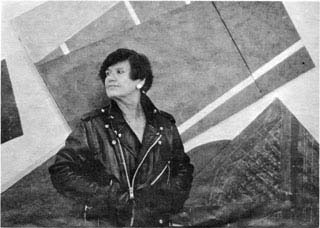
Elena Urbaitis in front of an installation of paintings in her studio.
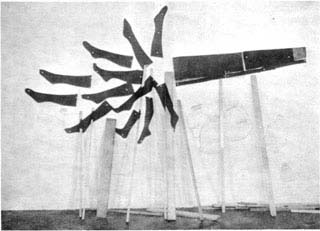
Installation, 1990, C.W. Post, Long Island University, N.Y.
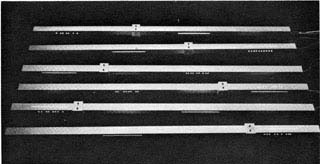
Light Bars Horizontal, 1980, aluminum, flourescent lights, 2"x2"x80"
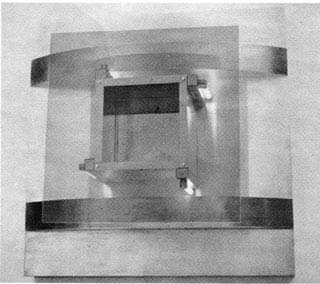
Quadare, from the series "Illuminated Constructions," 1979, aluminum, flourescent lights, 33"x33"
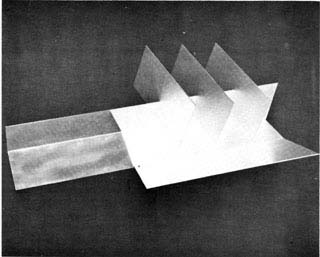
Solar, from the series "Illuminated Constructions," 1979, aluminum, flourescent lights, 43"x21"xl3"
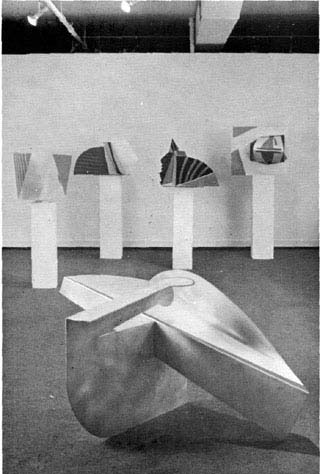
Messengers, 2984, installation, Pheonix Gallery, New York
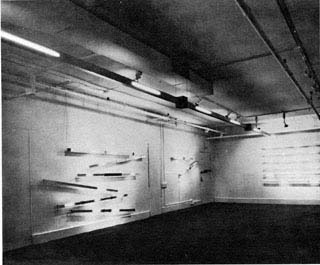
Light Bars, 1980, installation
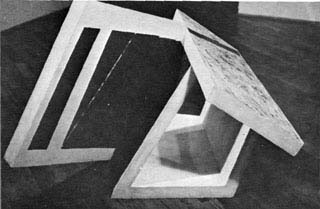
Earth Bound, 1987, from the series "Painted Surfaces." wood paint, 30"x40"